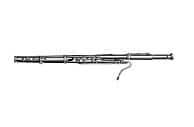Before entering fully into the meaning of the term bassoon, we are going to discover its etymological origin. In this case, we can state that it is a word that comes from French, specifically from “fagot”, which can be translated as “bundle of firewood”. A Gallic word that, although it is not known for certain, it is considered that it could derive from the Greek noun “phákelos”, which is synonymous with “beam”.
A bassoon is a musical instrument that is made of wood. It is a wind instrument , which consists of a tube more than one meter long with keys, holes and a mouthpiece.
 The origins of the bassoon date back to the beginning of the 18th century . Over the years its structure underwent various modifications until in the 19th century it acquired its current shape.
The origins of the bassoon date back to the beginning of the 18th century . Over the years its structure underwent various modifications until in the 19th century it acquired its current shape.
The bassoon is a conical tube that is folded on itself. The contrabassoon and fagot are instruments from the same family , while the heckelphon and oboe are other instruments with similar characteristics.
Generally the bassoonist plays his instrument sitting down. It is common to have a harness or strap to hold the instrument, which is held in the same way as the tenor sax. With the left hand, the bassoonist plays the upper keys, while the right hand is allocated to the lower keys.
In addition to everything stated above, we can point out another series of interesting facts about the aforementioned instrument called bassoon, among which are the following:
-It has the particularity that it blends very well with other instruments, especially with horns.
-Its structure is made up of five fundamental parts: the pavilion, the central body, the neck, the neck and the stock. However, we must not forget the thumb support either.
-It is considered the “natural bass of the wood family.”
-You may not know it, but he is known in certain musical circles as the orchestra clown. Because? Because it allows you to make very fun and comical sounds.
Vibrato and trill are some of the techniques that can be performed with the bassoon, a double-reed instrument (or double reed) that has been used by figures such as Antoine Dard (1715-1784), Víctor Guillermo Ramos Rangel (1911-1986) and Maurice Allard (1923-2004) among the most virtuoso musicians who have played it.
In the same way, we should not overlook other musicians who have become important figures for their way of playing the bassoon. This would be the case, for example, of the American Judith LeClair, who began her professional career when she was only 15 years old and who, since the 1980s, has served as principal bassoonist of the New York Philharmonic.
Wolfgang Amadeus Mozart, Antonio Vivaldi, Richard Strauss y Johann Christian Bach (hijo de Johann Sebastian) son algunos de los grandes compositores que han creado concerts para fagot. El instrumento suele emplearse en composiciones de música de cámara, música barroca y, en algunos casos, jazz.
